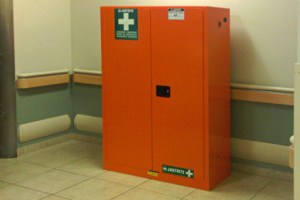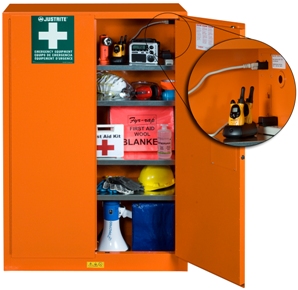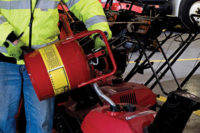 Emergency preparedness! What does it mean? It means anticipating any situation that puts one in harm’s way, and then providing the means to cope with that situation. Fire, flood, earthquake, explosion, volcanic eruption, hurricane, tornado, lighting strikes, power failure, snow storm or blizzard – whether on the job, at home, while traveling, or attending a major league baseball game – all these disasters evoke images of destruction and emotional turmoil. What about medical occurrences, be it heart attack, stroke or something else - all of these speak “emergency.” How about terrorism in its many forms? Reports of these kinds of events scream at us daily on the web, TV, radio, magazines and our daily newspapers.
Emergency preparedness! What does it mean? It means anticipating any situation that puts one in harm’s way, and then providing the means to cope with that situation. Fire, flood, earthquake, explosion, volcanic eruption, hurricane, tornado, lighting strikes, power failure, snow storm or blizzard – whether on the job, at home, while traveling, or attending a major league baseball game – all these disasters evoke images of destruction and emotional turmoil. What about medical occurrences, be it heart attack, stroke or something else - all of these speak “emergency.” How about terrorism in its many forms? Reports of these kinds of events scream at us daily on the web, TV, radio, magazines and our daily newspapers.
Armed with information, we try to “Be ready.” We stock up on supplies and equipment; we plan evacuation routes. We hold drills to practice for these disasters. Our plans depend on where we are. Needs differ in different occupancies.
Let’s look in on a hospital, specifically a Veteran’s Administration hospital in Long Beach, California. Eric Pieper, Emergency Preparedness Manager, and his team had their plans in place. They knew their roles and the role of the first responders who would join them. The appropriate protocols had been established for a myriad of different disaster scenarios. Drills were held on a regular basis. Every aspect of each drill was examined, evaluated and graded.
However Eric Pieper was troubled by a recurring problem that was common to all the drills. The hospital was in dire need of places to store and deploy emergency supplies and equipment throughout the facility. Time lost in getting to these items only worsened the consequences of a potential disaster.
Eric went to work with his staff. They analyzed what supplies and equipment would be needed and determined the best strategic locations for storage and deployment. This list included: hardhats, high viz vests, leather and waterproof gloves, headlights with batteries, light sticks, Mylar blankets, spill kits, over the shoe boots, first aid kits, safety goggles, N95 face masks, eyewash and “Do Not Enter” tape among others. They then began to develop specifications for a storage cabinet. The basics were obvious. Fire resistance was a must; seismic protection was needed; strength and durability were required. The cabinet must be secure, yet easily opened in an emergency. A three-point stainless steel latching system with a locking handle met the need. Duplicate keys assured a backup was available if needed.
Visibility was extremely important. Anticipated power outages meant supplies had to be located in the dark. GloAlert glow-in-the dark identification labels were needed to facilitate quick location during an emergency. In light conditions, a powder coat, high visibility orange finish was determined to be needed to raise awareness levels and make these emergency supplies quickly accessible. Within the facility, only the “Emergency Preparedness Cabinets” have this orange finish, making them stand out from other types of storage cabinets.
 Among other items to be stored in the cabinets are radios, flashlights and walkie-talkies. They must remain charged and ready for use at all times - the solution, a built-in power port. The cabinet should be equipped with an electrical pass-through connection including an external power cord and 10-Amp rated, six-outlet power strip.
Among other items to be stored in the cabinets are radios, flashlights and walkie-talkies. They must remain charged and ready for use at all times - the solution, a built-in power port. The cabinet should be equipped with an electrical pass-through connection including an external power cord and 10-Amp rated, six-outlet power strip.
With these specs in hand Eric began his search for a vendor. With the help of the Government Account office of a large MRO distributor, the search for a storage solution soon led to Justrite Manufacturing Co., a steel safety cabinet manufacturer with over 100 years of experience in the safety industry. Working with Justrite engineers, a final design was approved. A contract was let and manufacturing began.
When interviewed on February 1st, Mr. Pieper explained that 50 of the unique “Emergency Preparedness” cabinets had been deployed throughout the Long Beach, VA facility. They have been well received by the hospital staff and a troubling problem has been eliminated. Going forward EMS personnel are responsible for maintenance.
Practice helps make perfect
When it comes to emergency management, the old adage “Practice Makes Perfect” is more like “Practice Helps Make Perfect.” The very nature of disasters sometimes uncovers unforeseen circumstances, so “perfect” might be difficult to achieve. However, mitigating hindrances by using practice drills to uncover and solve potential issues such as having segregated, dedicated storage for emergency supplies, goes a long way in helping emergency responders do their work in assisting and protecting people during difficult times.
Storage! Vital to Emergency Preparedness


